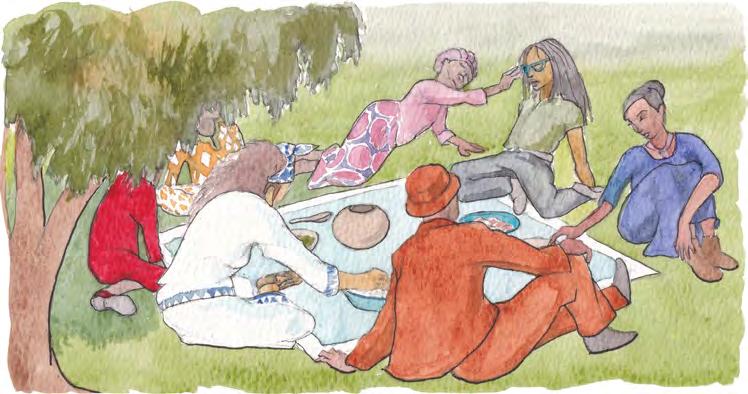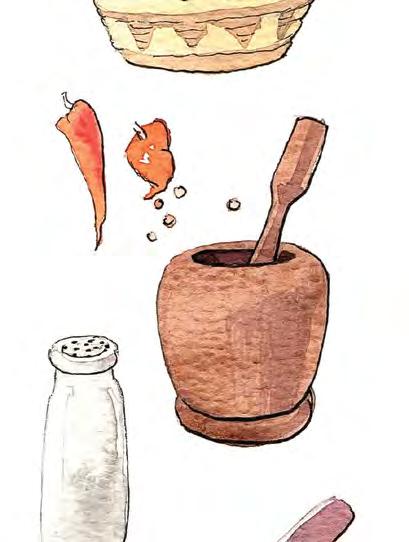
31 minute read
Making Healthy Food Happen! Using a Barefoot Guide Approach
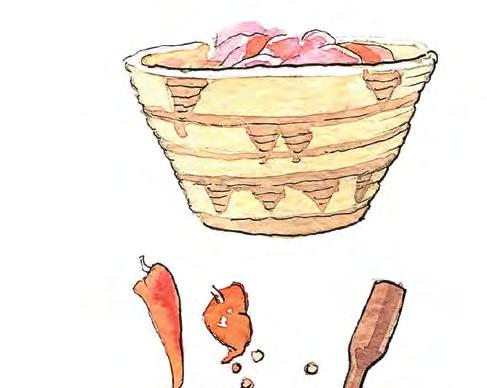
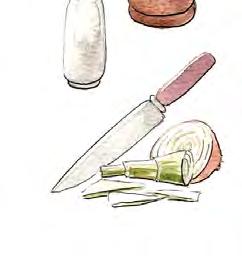
Advertisement
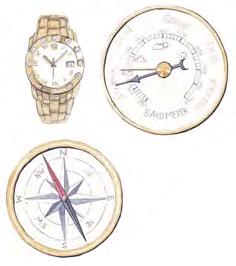
8 Making Healthy Food Happen!
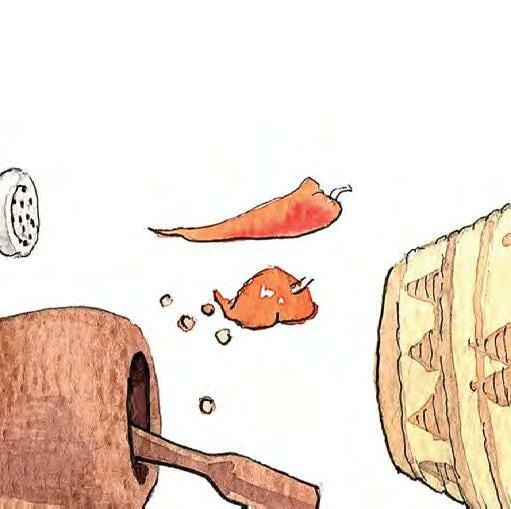
Using a Barefoot Guide Approach
In your bones: knowing versus understanding deeply and then acting
“How does one change bad eating habits?” asked Monica.
“First you have to understand what healthy eating is,” suggested Fanza. “If you understand you’ll change.”
“Yes, I agree,” said Abdou, “but it has to be a certain kind of understanding. The understanding has to be deep in your bones! The type that compels you to change!”
“That’s a good way of putting it, Abdou,” said Monica. “Simply knowing about something is not enough. A deeper understanding is required. But how?”
“I read somewhere that we remember 10% of what we read, 20% of what we hear, 30% of what we see, 50% of what we see and hear, 70% of what we discuss with others and 80% of what we personally experience!” said Kamali.
“That sounds grand,” chimed in Fanza, “but what does it mean in practice? People can’t eat grand words, and people cannot eat workshops, my mother always says.”
“What do you think it means in practice? I’m not just asking Fanza, but all of you. Tell me,” responded Monica patiently, noticing Fanza’s irritation.
No one spoke for almost thirty seconds. Then Estridah looked up, “I remember each and every story we read. And all the discussions really have helped me to change the way I’ve been eating. I’ve stopped eating junk food and sugar. That is the first thing I needed to do. And now I am trying to eat as much diverse foods as possible, using different colours as a guide too. I’ve also been having very interesting discussions with my mother about our traditional foods in northern Malawi. I’m very keen to help revive many of them, as well as eating them myself.”
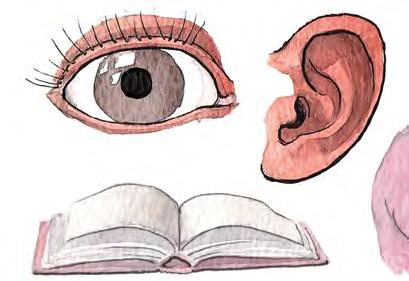

Njabulo exclaimed, ““Maybe healthy eating and reviving traditional foods and diets is in your bones now, Estridah! The stories brought it home for me! What also helped me was when we cooked some traditional meals together and discussed what we were doing. Eish! I’ll never forget those. It really came home to me how rich our traditional foods, diets and cuisines are across Africa. Everywhere there’s that local diversity that makes for healthy eating. Before we did that, I had thoughts about traditional diets being good. After we did it, I knew how good they are!”
“In your bones too!” said Ajay laughing.
Monica throws a cat among the pigeons
“Next week,” Monica came in again, “you’ll be attending two community groups holding action meetings on healthy food. The first is with a women’s group, Kiwala Village Savings and Loans Club, in a rural area near Masaka. The second is the Kibuli Hill Community Group, with a number of young urban residents, here in Kampala, who are meeting to deal with the increasing numbers of lifestyle diseases like type 2 Diabetes, high blood pressure and cancer. You are going to help out with the meeting by performing a short drama.”
“What!” cried the students in unison. “But we are not drama students!” said Abdou.
“Speak for yourself,” said Fanza with a dramatic gesture, “I won the acting award at school, thank you!”
“I don’t want any arguments. To do this work you must have many skills. Fanza, you can be the director. Here is the story to dramatise. And please, everyone, put on a convincing act! And Kamali, I would like you to facilitate the discussion after the drama. When we meet the following week, we’ll discuss how it went.”
How the Bujenje Village Savings and Loans Club use stories as a discussion starter
“I recently read that almost one third of children under five in Uganda are stunted. Why is that the case? It’s shocking. Our village savings and loans club, which we call our bank without walls, has been quite successful. We often get visitors to hear about it. Last week there was a group from the FAO wanting to learn about our success. But money isn’t everything. Especially if you aren’t healthy.” So began Masiko, the Chairperson of the Bujenje Village Savings and Loans club.
The members of the group sat in a circle next to her. Sitting on the side were a small group of students from Makerere. They were all sitting in a thatched, open-sided hut with low mud walls to sit on. This served as their bank’s headquarters. The members could hear in Masiko’s tone that she was worried. There was silence as she paused. Then she continued.
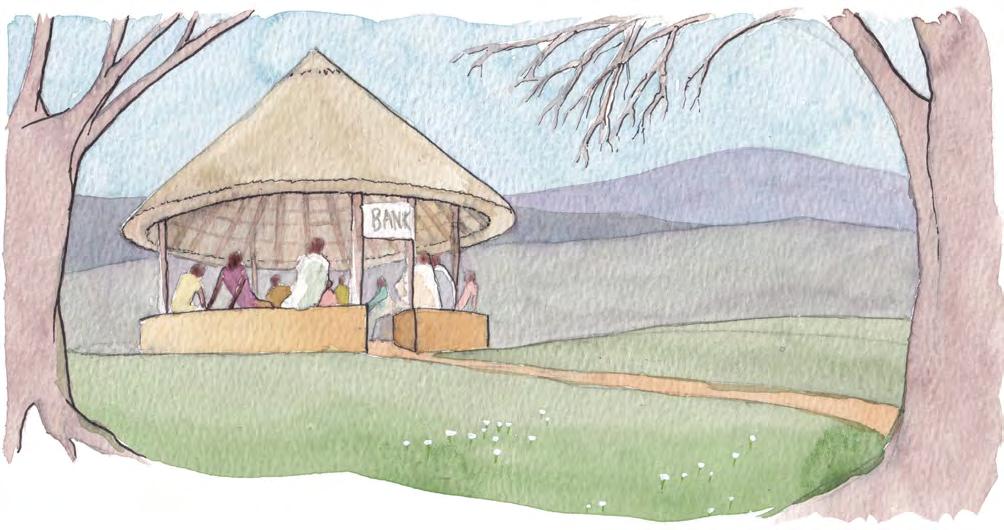
“We’ve become a shining light in our community. We’ve shown how to mobilise our own resources to help each other. I think it’s now our responsibility to do something about the way our eating patterns have been changing and changing for the worst. What you choose to eat is a complex topic. We need to understand it well and base our action on that understanding.
“To help us understand we’re going to use our story method again. Remember how we used a story when we first started. That’s what really empowered us as a group to understand our situation and then to take action. This is how we set up our successful savings and loans club. We had such a rich discussion. Out of that discussion came the understanding and the action. Let’s do the same towards much healthier eating in our community.”
Miremba will read our first story. It comes from a Barefoot Guide called: ‘My Food is African: healthy soil, safe foods and diverse diets’. Grace has translated it into Ganda. “Over to you Miremba.”
Miremba stood up and slowly read the following short story: Remember how we used a story when we first started. That’s what really empowered us as a group to understand our situation and then to take action.
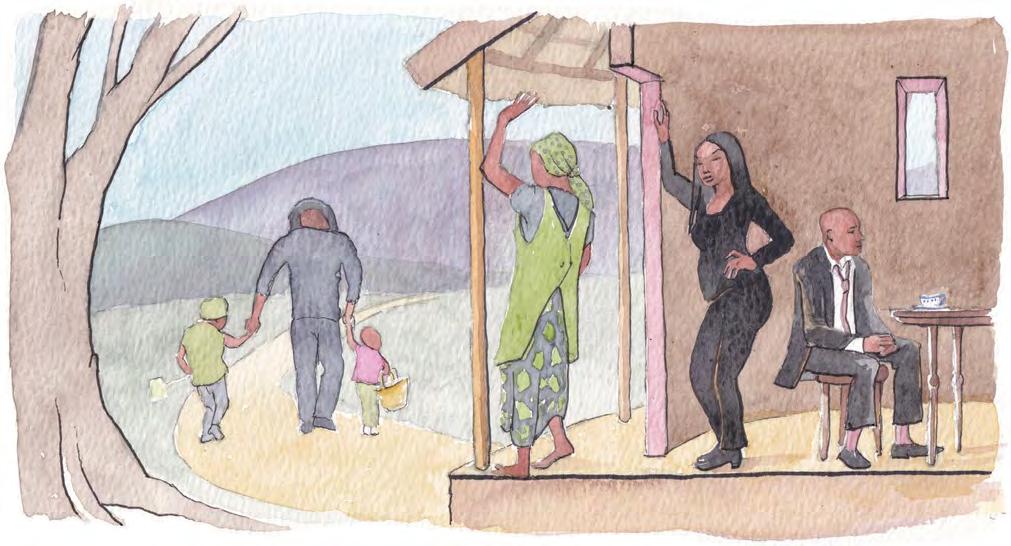
Grandma’s Special Food
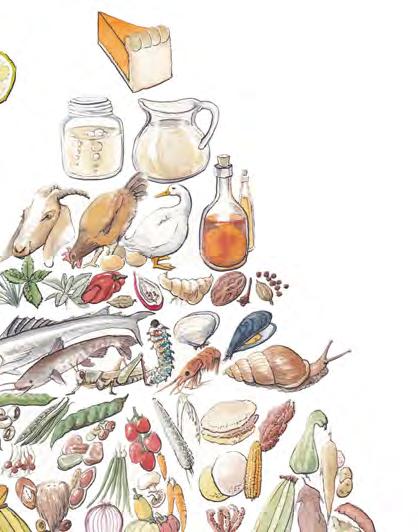
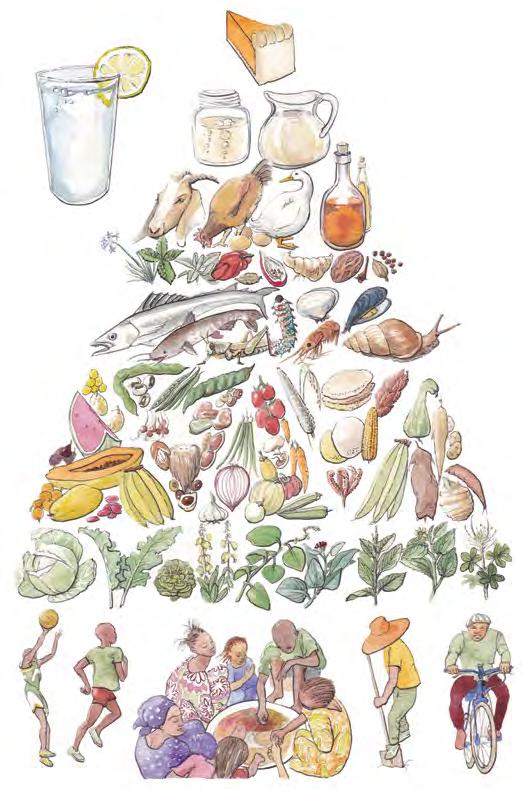
We sit outside under a tree on a reed mat and greet each other. Grandmother, who is all smiles, dashes into the kitchen and brings out boiled groundnuts and a dish with a mix of beans and maize grains. We kids also get to eat the baobab fruit, with some fresh milk from grandma’s cows. I know my grandmother wants to ask my parents why we don’t visit more often and why we never stay the night. I’m also thinking about how I can get out of washing the dishes. It’s exciting to be visiting my grandparents again. I am here to enjoy myself and feel free.
Grandmother gets busy preparing a meal for us. I watch her take down the long pieces of dried meat hanging in the kitchen and break them up into smaller pieces. She boils the meat until it’s tender and adds peanut butter to make a sauce. For vegetables, she picks pumpkin leaves, washes and chops them, boiling them until they’re soft. She adds a little cooking oil. Lastly, she cooks a thick porridge from red sorghum, doing this with great skill to avoid spillages.
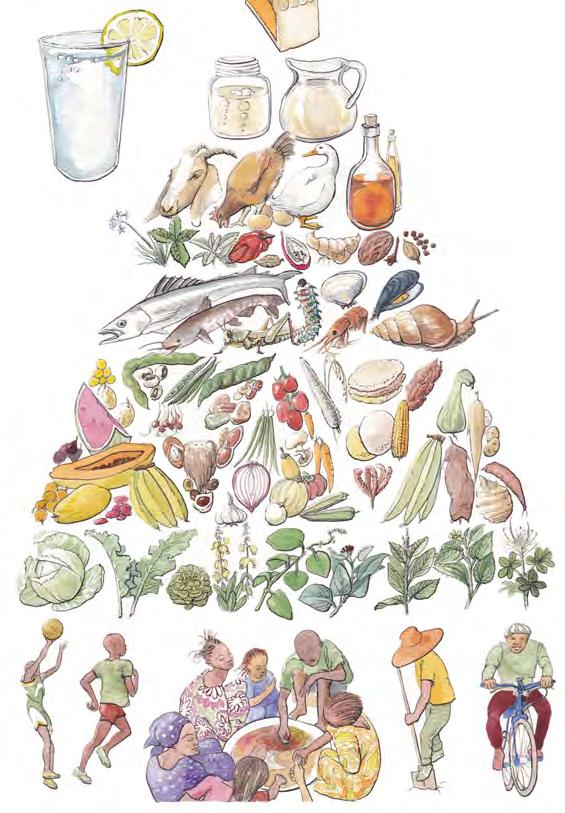
I watch my father perched on a stool, all prim and proper as a good son should be, but I can see by the way he is looking, and not saying anything, that he is uncomfortable. No doubt he is also wondering when the meal will be finished so that we can head You can feel the tension back to town. After eating, he continues to say nothing. Did he not in the air. Grandmother, enjoy the delicious meal? like grandmas do so often, is making the My Grandfather calls me and my sister to go to the fields. There, we find some red-fleshed melons and soon we are scooping out chunks with our hands and drinking the juice. How refreshing! We best of it. It shows the collect the melon seeds and give them to grandmother to dry. gap between urban and Later, as we leave, our car full of grain, wild fruits, and other rural lives. foods from my grandparents, I feel sad. However, I know I have to go back to town with my parents. I think about what we eat in town: super-refined maize meal, white rice, meat and a few vegetables. We often snack on sweets, biscuits and sodas/soft drinks or the popular and sweet Mazowe orange drink. Who would dare cook the type of food my grandmother cooks? Who would eat it?

DISCUSSION IN THE GROUP:
When Miremba had finished, Masiko let the story sink in before asking: “What happened in the story, including what feelings you noticed?”
“It’s obviously not set in Uganda, but it could be in some ways. It’s about the relationship between town and rural relatives. You can feel the tension in the air. Grandmother, like grandmas do so often, is making the best of it. It shows the gap between urban and rural lives.” These remarks came from a middle-aged woman called Namono.
“Why does her father feel uncomfortable do you think?” asked Masiko.
“I think he sees the rural life as backward and is embarrassed by it,” another woman called Namazzi chipped in.
“Why does the writer feel sad when she has to leave?” Masiko then asked.
“She’s still a child and has that innocence. She appreciates the rural life and the warmth of her grandma. She does exciting things when she’s there,” another young woman with a baby, sitting next to Namazzi, responded.
“The same thing’s happening here,” Namono jumped in again. “People in urban areas are changing their diet to refined foods and lots of what people call junk food. It’s almost as if that’s what you’re expected to eat if you live in an urban area. It’s also about status.”
“And we’re beginning to do the same in rural areas, especially younger people,” said the young woman with the baby. “Those foods are easier to prepare and quicker.”
“It’s also difficult because now we grow maize everywhere and have stopped growing some of the other staple foods. And we too are connecting anything traditional to being backward.”

The group continued their discussion, still referring to the story but gradually talking more about their own situation. After about an hour, Masiko came in with this question:
“So, what should we do about the situation? How can we help change things so that people recognise the great value of traditional foods?”
“I think we must document all our foods, dishes and drinks and the different ways these are eaten,” said an older woman who hadn’t spoken until then. “Some of us with knowledge that’s been passed down to us are getting older. We don’t want to die with this knowledge.”
“Why don’t we take it in turns to prepare something to eat for our meetings?” asked Namazzi. “And then we could document it at the same time, writing down the recipe and taking a photo too.”
They followed this idea some more and then agreed on a roster of sharing. There was an excited buzz as the members of the group left the meeting.
How the Kibuli Hill Community Group use a short drama as a discussion starter:
“Welcome to today’s meeting of ‘Kibuli Hill Community Group’. For those who are new, the group’s aim is to help each other live healthier lives. We have also invited these six students from the University to participate. Welcome to everyone. We formed the group because some of us are very worried by the rapid increase in illnesses like type-2 Diabetes, high blood pressure and a range of cancers. We believe that we can deal with these in our lifestyles. Many of these illnesses never used to be around in Uganda. They are modern illnesses. Just relying on medicines is simply continuing to treat symptoms. These medicines may be necessary to some extent, but we believe it’s time to address the root causes.”
“Let’s do a round of introductions. I’ll start with myself. My name is Dembe Akello and I’m a primary school teacher.”
“I’m Charles Otim and I recently finished my degree at the Martyrs University.”
“My name is Abbo and I’m an accountant in a small trucking company.”
“I’m Agnes Kiiza, originally from Masaka but moved here to Kampala 15 years ago and am a vendor in Nakasero market.”

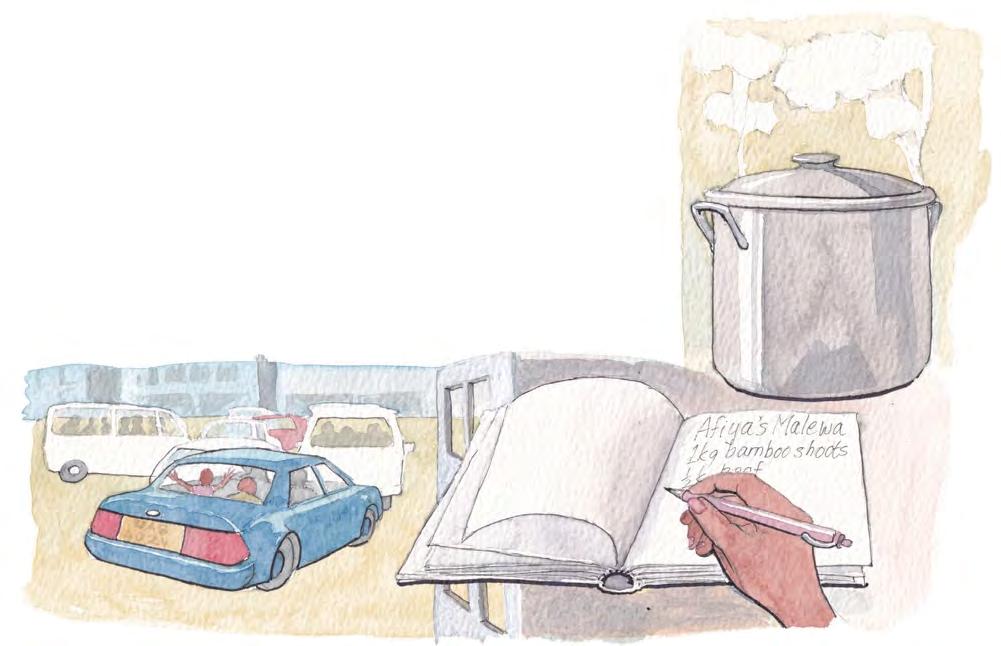
“We want to make our gatherings fun and interesting,” Dembe continued. “Today, we’ve invited students from Makerere university to lead the session. Over to you Kamali and team.”
The six students moved into position for a short, mimed drama, which went like this:
In the centre are two young people working away at their computers and on their phones. The one is a very overweight young man (padded up to look like this). He tends to get easily distracted. The other is a young woman. A clock chimes to indicate lunch break. They both get up and go out in different directions.
At the same time as the above, there are two other scenes on either side: one is of an older woman working away in her kitchen preparing a variety of dishes – cutting, stirring, seasoning, tasting etc. She moves with unhurried intention. The other is of a fast-food outfit with a sign saying something ‘Donald’s fast foods’, where a couple of people are rushing around serving portions of chicken and chips. They are frenetic.
The woman walks slowly and easily to the scene where the older woman is preparing a meal. She greets her in a friendly way and they chat. They appear relaxed. They sit down together and, in a leisurely way, eat their meal together. There are a number of dishes and that are obviously tasty.
The overweight young man keeps looking over his shoulder as he approaches Donald’s Fast-Food outlet. He goes in, smells the aroma, and then reluctantly goes out again. He does this a couple of times, obviously having difficulty making up his mind. Eventually he gives in and walks up to the counter and orders, all the time glancing back over his shoulder as if checking if someone is watching him. He moves around nervously as he waits for the order. When his number comes up, he snatches the order from the fast-food worker, who’s upset about this. There’s a bit of an argument before the customer pays and leaves. Once outside the shop, he gobbles up his takeaway very quickly.
Both office workers then return to their work. The one works away steadily and easily. The other continues to get distracted and rubs his stomach, as if with an ache. And he takes out sweets and keeps popping them in his mouth. The end of the day comes, and they both leave.

“Hi everyone, so I am Kamali from Ethiopia. Thank you for letting us participate and learn from you. So, we’d like to discuss our short drama today,” started Kamali. “Could one of you describe what you saw happening in this drama?”
“There are two people working in an office who go for their lunch in different places,” began Agnes, “one goes home and the other goes to a fast-food place.”
“I didn’t think she went home, I thought she went to a local restaurant selling traditional foods,” suggested Charles.
“I guess it could be either,” responded Kamali. “How did the two show different feelings?”
“The young woman was relaxed while the young man seemed to feel guilty about what he was doing,” said Abbo. “He seemed very uncomfortable and then at work he never seemed able to concentrate.”
Other members of the group came in and shared how they saw it. Kamali then went on to ask what the main message of the drama was and the group discussed this.
“How does the drama relate to your own lives?” Asked Kamali.
A middle-aged woman called Namono spoke up. “I have a nephew who’s just like the boy in the drama. He’s only 24 and is very overweight. His mother is worried about him but whenever she raises the topic of his weight, he gets moody and upset, and refuses to talk about it. What can she do?”
This led into a discussion amongst the members on how to deal with such a situation.
“How can we help such young people go to the place serving traditional foods rather than the junk food?” was the way one member put it. “Young people seem to have a resistance to traditional foods,” she continued.
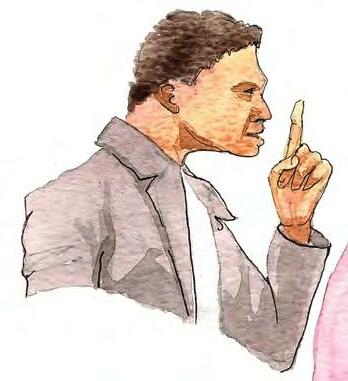
“Maybe older people shouldn’t talk about ‘going back’ all the time,” suggested Charles, the recently graduated young man. “That puts young people off. Is there a way to make traditional foods appealing and modern to young people?”
“That’s a good point,” said Dembe Akello, the chairperson of the group. “There’s also the point that our different traditional diets in Uganda take time to prepare. They are very healthy, but my recently married daughter is always complaining to me how long traditional dishes take to prepare. What can we do about that? She says she just doesn’t have the time.”
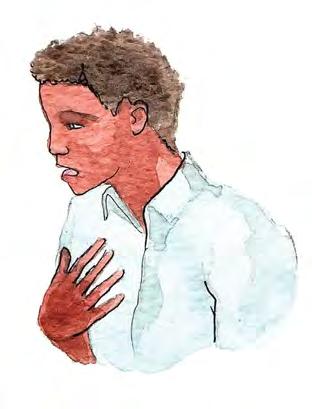
The group continued to discuss how they could encourage young people to prepare and eat healthy meals. One person suggested the next time they meet as a group they all bring an example of how they have speeded up their preparation of a healthy dish. Another suggested that they organise an annual food market in the area to celebrate healthy eating.

“Yes, that’s a great idea,” said Agnes Kiiza, “that could help give status to such foods. We could invite musicians to play at the festival and have a small charge to cover the costs.”
“The aim would be for people to have fun,” continued another member, “and the healthy eating would be linked to that. We could have pamphlets about healthy eating for those who are interested.”
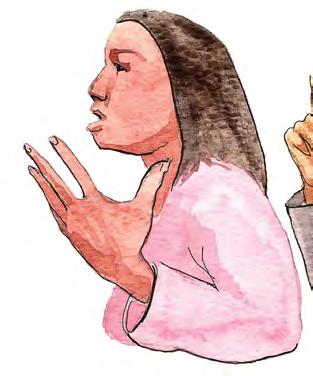

“Our time has run out,” said Dembe, “but let’s think about that idea of having a festival and we can discuss how we do it at our meeting next week. Many thanks to Kamali and her team for leading us in this very useful discussion.”

Capturing and discussing our biodiverse foods
This is an exercise that records the diversity of foods in an area and how widely the group discussing them eat each food. It then can open up discussion around specific ways to increase the diversity of foods in people’s diets.
A. Create a four-cell diagram on a large piece of paper or on the ground or on a flipchart stand.
Give the following headings to each cell:
Top left: Eaten often by many people Top right: Eaten often by few people Bottom left: Eaten rarely by many people Bottom right: Eaten rarely by few people.
B. Ask the group to name a food that they eat. Then ask the group how many people eat that food and how often they eat it. Write the name of the food on a small square of paper (or draw a picture of the food) and place the small square in the appropriate cell. Then ask for the name of another food and do the same. It’s important to keep going until people can’t come up with any more foods so as to capture every food being eaten.
You could also ask: “Are there any foods that used to be eaten and no-one eats them anymore?”
These would go somewhere outside the four cells.
C. Then open things up for discussion. You could ask a question like: “If we think about our discussions on healthy eating, what is this diagram telling us?” And then probe with more questions to move towards a common picture of the current situation.
CHIPS PAP
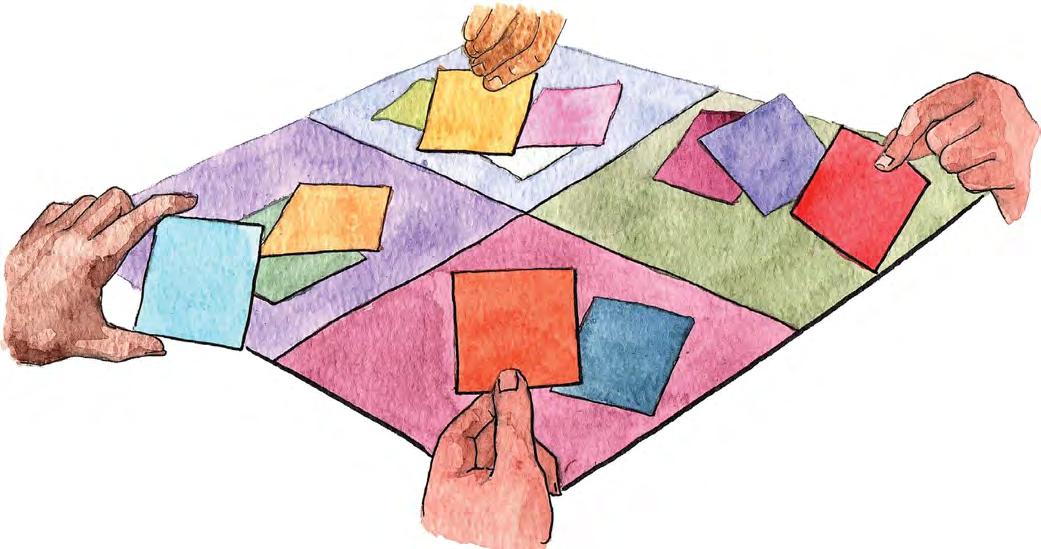
GREEN VEGGIES
RARELY BY FEWOFTEN BY FEW
BERRIESMUSHROOMS
OFTEN BY MANY KFC RARELY BY MANY PUMPKIN
LOCUSTS
D. Then, when appropriate, shift the discussion to: “What can we do about this situation? How can we improve things?” Then finally: “So what are we going to actually do? What’s our plan?”
BIG BRA D N S LOCAL BUS I I N ESS
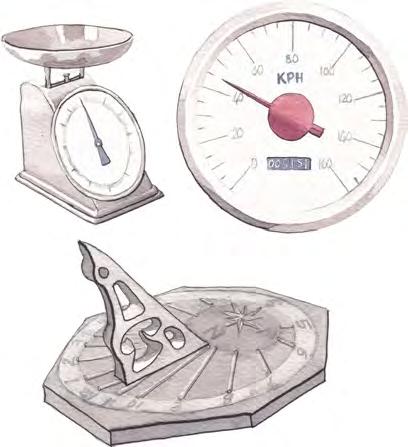
AGE
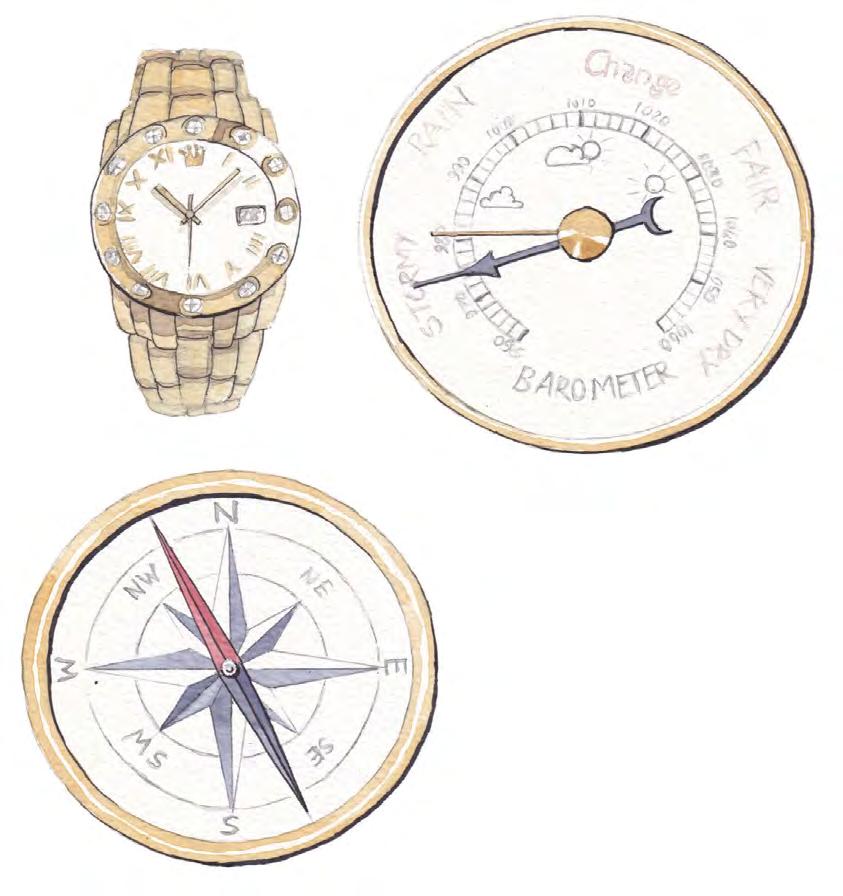
YOUTH
MODERNITY TRADITI O N

Suggested guidelines for USING this Barefoot Guide in groups
This is a guide for community group leaders, or NGO practitioners or government health or agricultural extension workers who are working with communities who are keen to improve their own and their families’ health through eating better.
Facilitating a community action discussion
1. Get to know the book well and all the stories. See them as a resource for you to use with groups you know. Knowing the different stories will allow you to select which ones are most suitable to your situation. 2. Use the stories to come up with similar stories of your own, adapted to your local context. 3. Have someone in the group or wider community read the story you’ve selected. You may need to translate it into the local language of your area. 4. Consider turning the story into a short educational drama with some volunteer actors from your group. This can be fun, particularly for young people. If so, it will be good to do a rehearsal with the volunteer actors. It doesn’t have to be perfect. 5. After the reading or acting out a short drama, use the questions we’ve included after each story or, better still, ask your own questions. 6. In order to carry everyone with the discussion, it’s often good to start with open-ended questions about the story itself, such as a. What were the most interesting things in this story? b. What was the main message in the story for you? c. What other messages were there?
Try to come to a common understanding about the story amongst everyone in the group, but don’t worry about differences on what the main message is. That’s fine. The aim is for good discussion.
How to encourage more participation
Many people struggle to contribute to group discussions. One way to help them is to use “buzzing with your neighbour”. How? Before you invite the whole group to discuss a question ask everyone to turn to their neighbour, and to chat about the question in pairs, just for a few minutes. This helps people to find their voices and explore responses before you open up discussion with everyone. Try it.
7. The next stage can be to help people to connect the story to their own situation. You can use questions such as: a. How does this story remind you of what it’s like here? b. What differences are there?
Let people discuss freely for a few minutes. 8. When enough understanding has been shared, you can then guide the discussion with questions such as a. What does this story teach us? b. What are all the possible ideas you have to improve our situation?
This is a brainstorm, so encourage people to freely think of many ideas. 9. Finally, you can lead the discussion decisions for action, with questions such as: a. So, what are the best ideas we can agree on to DO something to make a difference? b. What will be the benefits of implementing these ideas? c. What might stop or discourage us from succeeding and what do we do about this? This can then lead to the group coming up with a simple plan that lists the actions, who will be responsible for each action, and a timeline of when the group wants to see the actions done.
Always adapt this to situation. For example, it might work to wait for the next meeting to go onto the action stage. But in the end, this is all about people taking action to change behaviour or strengthen appropriate behaviours to link healthy soils to healthy plants and diverse diets with local foods.
MONOCROPS DIVERSITY
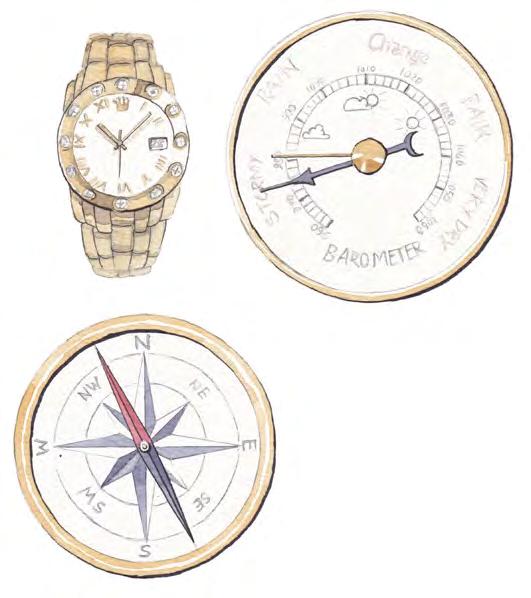
Additional actions that could help bring about change
• Identify farmers in the area who already know how to make the transition to healthy soils, healthy plants, and diverse crops. • Find NGOs or leaders in the district, or government extension staff who have technical experience with natural farming techniques that improve soils, and generate healthy plants. And check if they’re willing to provide support. • Seek out women and families that are known to have diverse healthy diets and arrange for others to visit them to learn from them. • Identify who within the community are ready to make changes. Think about how to support them and to connect them to support each other. • Test out new ideas and practices on a small scale, including on-farm experimentation. Bring people to these sites to learn. These visits could include cooking demonstrations. • Make visits to the local markets to see the variety and quality of local foods available and the prices, as well as the presence of highly processed foods and sugary drinks.
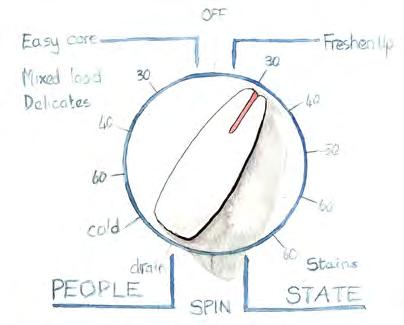
We’re sure you can think of others for your situation.
“Relationships between men and women can have a lot of bearing on whether people can eat healthily. ..." What are the forces stopping the move to healthier eating for everyone?
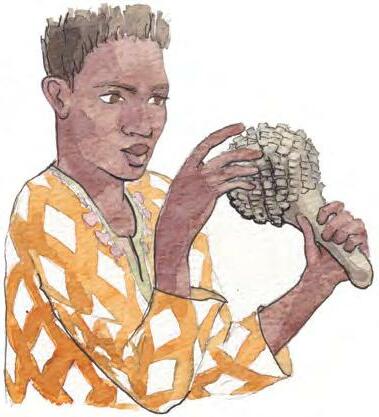
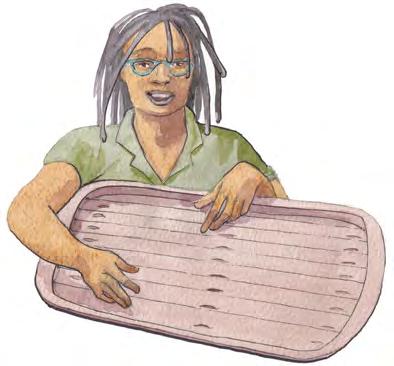
Monica was feeling satisfied. Her students seemed to have grown so much. They were more thoughtful, more confident and more serious about their studies. And they were also closer as a group.
“So far, we have been focused on what is unhealthy or healthy food in Africa and how to help people and communities to understand and change their habits. But what else do we need to focus on?”
Ajay looked up and began: “The big drive for production in my country has meant a shift from fields full of diverse foods to monocropping of maize in particular. It upsets my mother a lot, but not my father. He calls himself a modern farmer. He’s taken back some of my mother’s land.
“She was telling me the last time I was home how she’s watched this happen all around her to other women as well. Many men often deride women’s fields with diverse food crops as backward. So, I was thinking, if men like this keep pushing for cash crops with that kind of attitude, they undermine all those food crops that women have been growing. If this doesn’t change it doesn’t matter how aware the women are about healthy eating. Is this an example of what you mean?”
“That’s a very good example,” Monica complemented Ajay. “Relationships between men and women can have a lot of bearing on whether people can eat healthily. What role to government and NGO staff play in the situation you describe?”
“Most of them are men,” continued Ajay, “and from what my mother tells me all they’re interested in is production. They have no interest in the diversity of healthy food crops that women have always grown in their fields. They support the idea that this is backward.”
“Yes, that’s what I thought,” said Monica. “Next semester this issue of the different perspectives of men and women will definitely be one of the topics we look at. What else affects whether people eat healthily or not?”
“In the last couple of decades Ethiopia has gone through an economic boom of sorts,” jumped in Kamali. “The food marketing situation has changed a great deal in
Addis. My aunt describes how she used to do all her shopping at local markets. Now she does most of her shopping at a new supermarket. It’s more convenient. Everything under one roof?
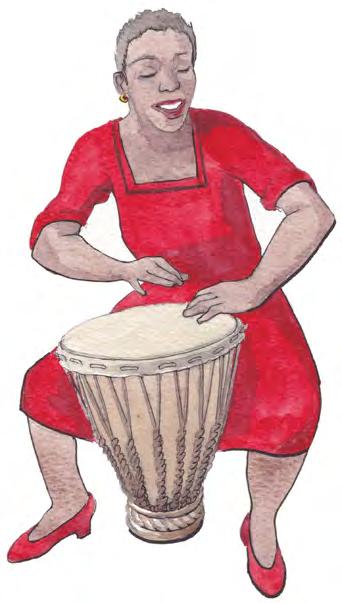

“One of my uncles in the USA told me it’s one big supermarket there. They are full of junk and over-processed food. You can get organic food but it’s more expensive and for richer people. What do we do about supermarkets? Isn’t there a role for African markets?” “Thanks, Kamali, that’s another big issue in the healthy eating discussion. If there aren’t supportive marketing situations it’s difficult for people to find the health promoting foods they need, at a cost that they can afford.” “What Kamali said has made me think of something too,” said Estridah. “As you drive into Lilongwe, our capital city in Malawi, there’s a huge advertising billboard from a big Southern African sugar company urging people to buy new, healthy sugar with Vitamin A added! From every side we seem to be bombarded by advertisements, on billboards, on the radio, tv, on social media pushing junk foods. Imagine pushing sugar as a health food!” “Our country has also been doing okay economically in the last decade,” started Abdou. “One of the results of this is a big rise in international fastfood chains in Dakar and other major centres. All the well-known ones are with us now and young people flock to them. They’re seen as modern and hip places to be. We have a big generational gap around food.” “In South Africa, in urban areas especially, people want dishes they can prepare quickly,” continued Njabulo. “Traditional and healthier dishes generally take longer it seems. People don’t have time. Also, they don’t want to spend time on cooking. That’s not a priority anymore.” “Thanks all of you,” said Monica joining in again. “I want to emphasise the point that if young people see traditional foods as backward then they’ll tend to avoid them, no matter what they hear from their mother about their health value. Part of modernity I think is also that children don’t listen to mothers that much anymore.”
“Another dimension that we’ll look at in the next semester is Government policies and approaches. In December last year, as you know, I attended the IUNS, the
International Union of Nutritional
Scientists’ conference in Tokyo. This is a gathering of those considered to be the leading figures in nutritional science around the world. They have a lot of influence. What they say affects what happens at country level. It affects where financial support goes for ‘nutrition’ improvement programmes.

“The way that Governments think about healthy eating and the policies they develop have a big impact on what citizen eat. This starts from how Governments promote what is grown, how it is processed and then distributed, leaving people with such limited and unhealthy choices when they go shopping for food. Another issue is about government policies for importing food. Many other countries subsidise their agriculture, for example for rice
MEN production in Asia, and corn production in the United States. Big Food corporations turn these very cheap crops into many ultra-processed products and sell them in Africa. Our own small scale farmers cannot compete. In West Africa, many countries import ultra-processed “perfumed” rice which many people in cities to buy because it is cheaper and easier to cook than local rice.
Then, Big Food corporations spend millions on advertising their ultra-processed foods, convincing people to buy their products, not locally produced foods.
Finally, you have to add culture, economic circumstances and many other factors to this. You have to look at the whole system that ultimately decides what people put into their mouths.”
“Next semester we’ll explore all those forces that work for or against people’s choices around food. And what needs to be done to change those.”
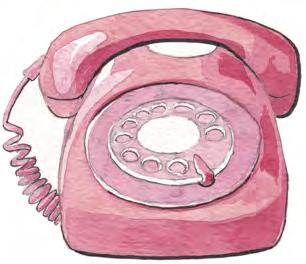
W O M E N
Drawing the threads of healthy eating together
“As we close this semester, let us distil the key messages we have come to. The headline for the semester was “Knowing and understanding the basics of what creates healthy food and what makes up a healthy diet. I would like to add a subtitle form Abdou: “Helping people to understand healthy food in their bones and then act!”
The students laughed and all looked at Abdou who smiled proudly at the acknowledgement. Monica continued:
“We’ve also looked at how we can help others understand the basics of healthy eating. This means enabling people to discuss healthy eating from many angles. Using stories or drama as a starter can help stimulate the discussions. Through discussion people understand much better. This can help them change, where change is needed. Or they strengthen their good eating habits.
“And we’ve engaged in helping interested people in communities to act on this new understanding: we’ve looked for practical examples, made learning visits, sought out technical support, and tested new ideas on a small scale. I am sure you have realised that it’s really not that complicated, but it does require a different way of thinking.” The students could see Monica’s eyes light up as she spoke. She loved this topic. “So, who can tell me what are the essential elements that go into healthy eating?”
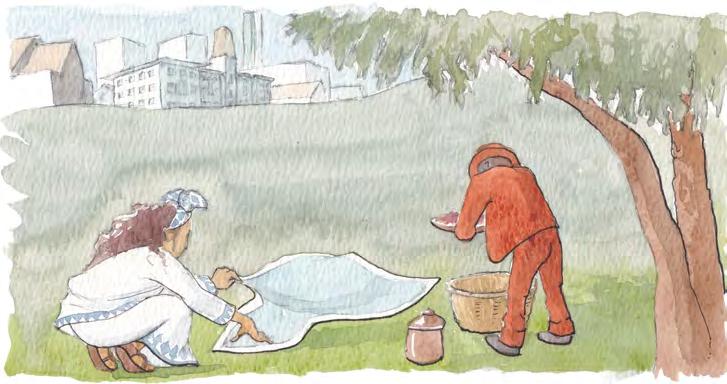
Fanza was first. “Healthy eating starts with the soil. With healthy soil that is alive with a multitude of diverse microbes and organic matter, healthy plants can grow, full of all sorts of goodness.”
Ajay followed quickly. “Synthetic chemical fertilisers and pesticides have no part in healthy soil. They may appear to produce healthy plants, but this is really just a plant on drugs. As with drugs, longer-term use means damage. Damage to the soil and to our bodies.”
The other students looked at each other, impressed by Ajay’s metaphor.
Estridah raise her hand to speak. “We also now know that having healthy stomachs, full of a diversity of microbes, is key to our health. That diversity of microbes in our stomach helps us turn the food we eat into healthpromoting energy. Eating healthy plants grown on living soil and having a healthy stomach microbiome will go a long way to making us healthy, wholesome beings. A vibrant part of the cycle of life.”
“And to get a variety of microbes you have to eat a variety of foods, of course,” Abdou jumped in. “I have learned that we need to include at least ten different natural foods in the meal. Don’t forget to throw in some powerpacked herbs for taste and health. And try to have foods of different colours.”
“My grandmother used to gather all sorts of greens for our meals when we visited her in my childhood,” Kamali added. “I always used to think she was wasting time doing this. But now I understand what she was doing. And she didn’t take that much time anyway, I was just being impatient.”
“How we prepare food also influences how healthy it is,” said Njabulo. “Grains need to be well cooked to help digestion, but we need to avoid over-cooking vegetables, eating them as fresh as possible. The best is if you grow them and cook them as soon as you pick them, or eat them raw if you can.”
“Adding local fruits into your diet will also help you be healthy,” added Kamali. “Often older people think these are only for children. True, it’s important that children eat lots of fruits, but they can also help adults be healthy too.”
“Excellent!” Monica exclaimed. “I am so impressed. Let’s keep it simple and not over-complicate things. That writer I quoted at the beginning of our course has perhaps the simplest guide of all: “Eat food. Not too much. Mostly plants.” He goes on to say: “That, more or less, is the short answer to the supposedly incredibly complicated and confusing question of what we humans should eat in order to be maximally healthy.”
“See you next semester!”
SUPERMARKET
STREET MARKETS
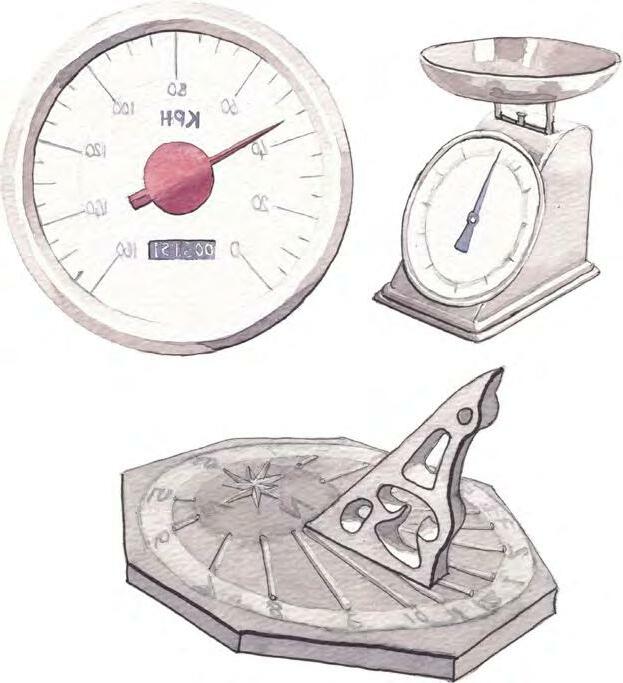
SLO W F OOD F A ST FOOD

